A Dive into the World of K-Pop's In-Ear Monitors
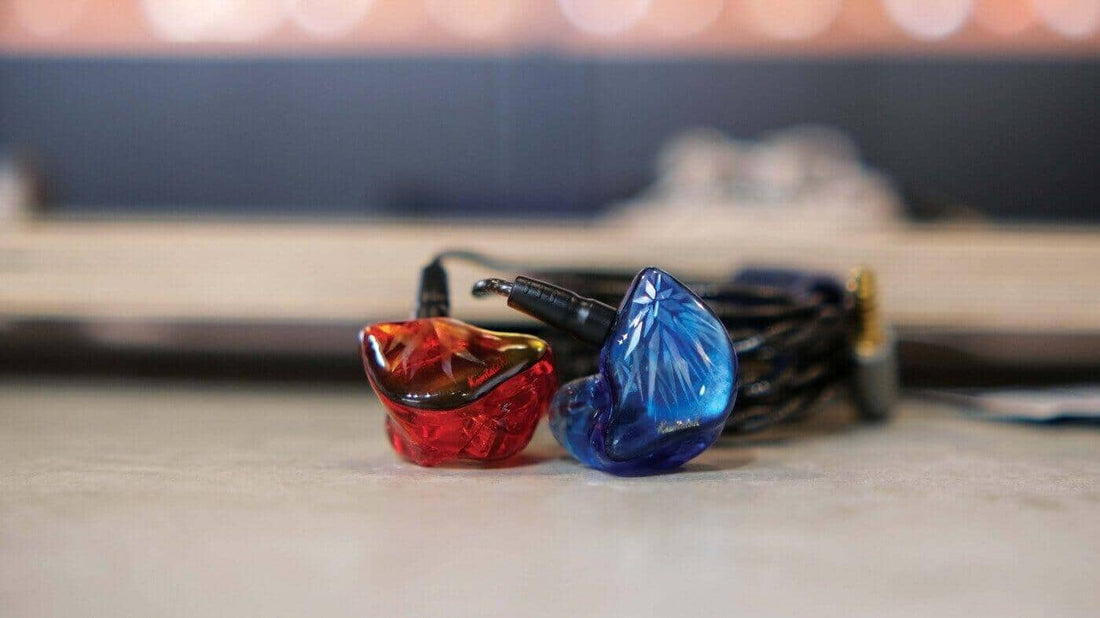
Introduction
K-Pop is the bane of many audiophiles who would criticize the genre for being less than "real" music; the spark of many a good-natured argument I've had with audiophile friends as a fan of the genre myself. However, leaving aside jokes and the question of K-Pop's audiophile merit, there's no question that K-Pop is an extremely merchandise-driven industry.
Fans purchase goodies like albums, posters, and light sticks in droves. But there is something you don't see much talk about: earphones. Many K-Pop artists use CIEMs, or custom in-ear monitors, that have been crafted to an artist's unique ear anatomy. CIEMs are essential for live performances, as they allow artists to block out crowd/stage noise and focus on the mix. Perhaps more interestingly though, CIEMs are expressions of artists' creativity and sensibilities, as CIEMs can be designed with custom graphics, materials, and textures for the faceplate. They're pseudo ear jewelry!
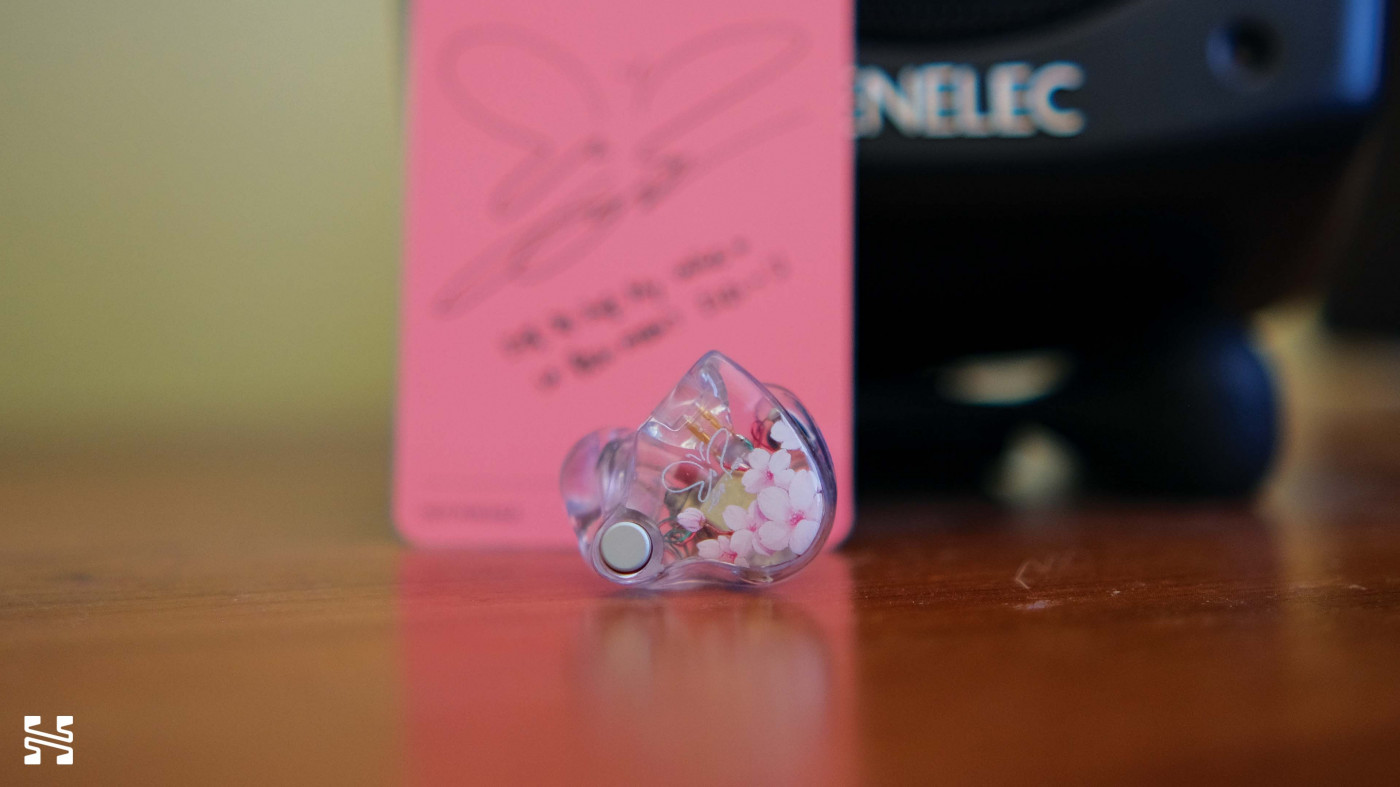
My custom 64 Audio A3t where I paired Taeyeon's signature with cherry blossoms. In-ear monitors are not only essential for artists, but they're also coveted by audiophiles for their superior audio quality compared to traditional earphones.
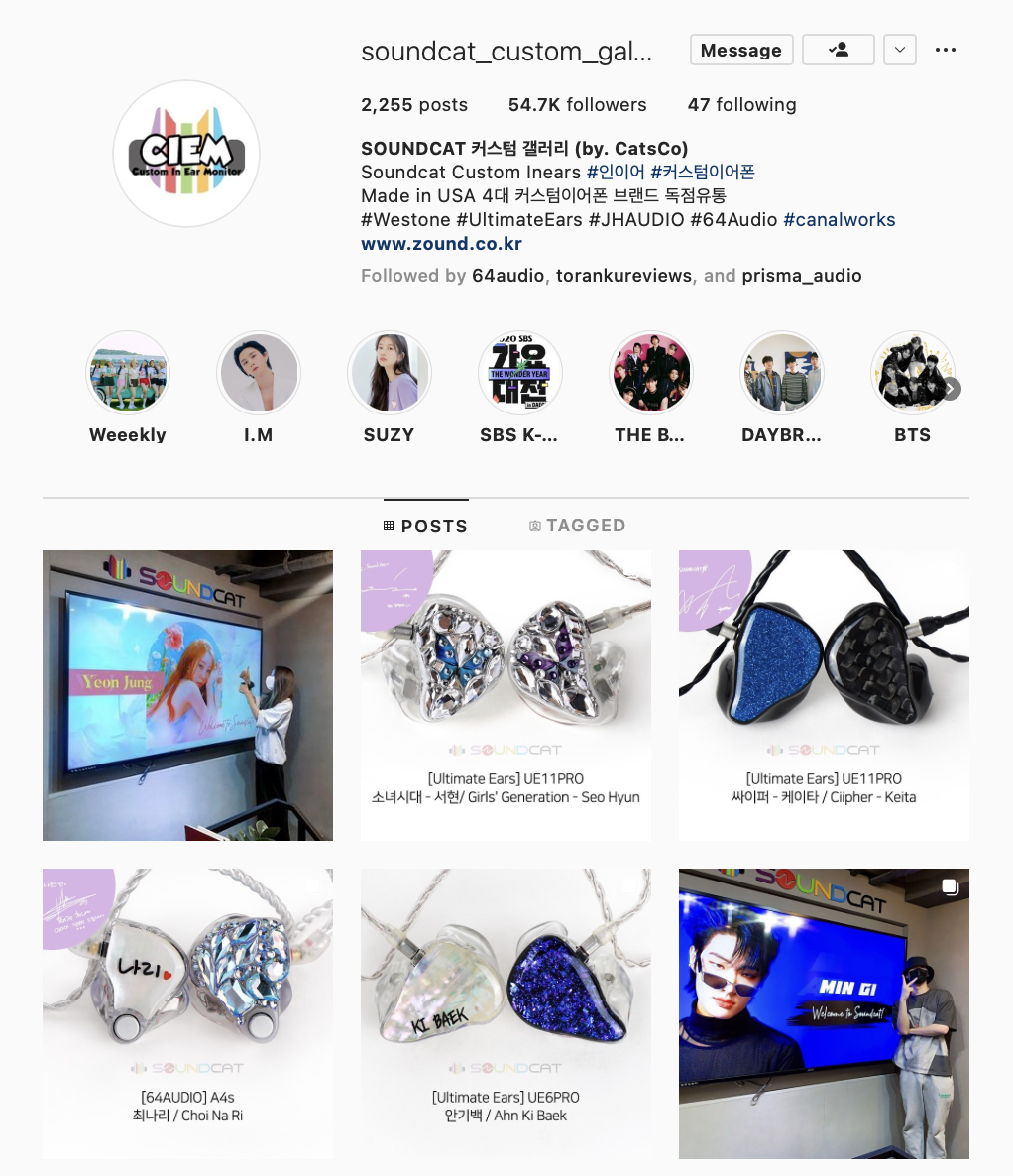
Above you can see a shot of retailer SoundCat's Instagram profile; SoundCat is the predominant retailer for South Korean artists. SoundCat fastidiously posts about new CIEMs that have been purchased from them, along with information on the artist and model of the CIEM. They have catered to numerous industry big names like BTS, Aespa, EXO, and IVE just to name a few.
Now, I could just slap some pretty photos that I pulled from their page, maybe add some commentary on the artists and their CIEMs, and call it a day like I've seen certain other posts do. But where's the fun in that? Due to the majority of K-Pop artists purchasing from SoundCat, the retailer's profile also makes a prime data source for what would otherwise be (and still is to some extent) a nebulous analysis of South Korea's CIEM market. And an overblown analysis of something this niche sounds exactly like something that would be in my wheelhouse.
So how can I analyze SoundCat's Instagram?
I had two approaches in mind. The quicker approach would be to scrape post data for hashtags and post descriptions. The more difficult approach would be to scrape the photos and then pull the text from them. This would be a more accurate method because SoundCat consistently uses the same format for the first photo of each post where it states the brand and the artist. In both cases, I would then feed the data through a visualization tool (Tableau) for further analysis.
Quicker Approach
Data was scraped using Apify's Instagram scraper for SoundCat’s last 2000 posts, which ended up covering the time frame of May 2017 to August 2022 (present).
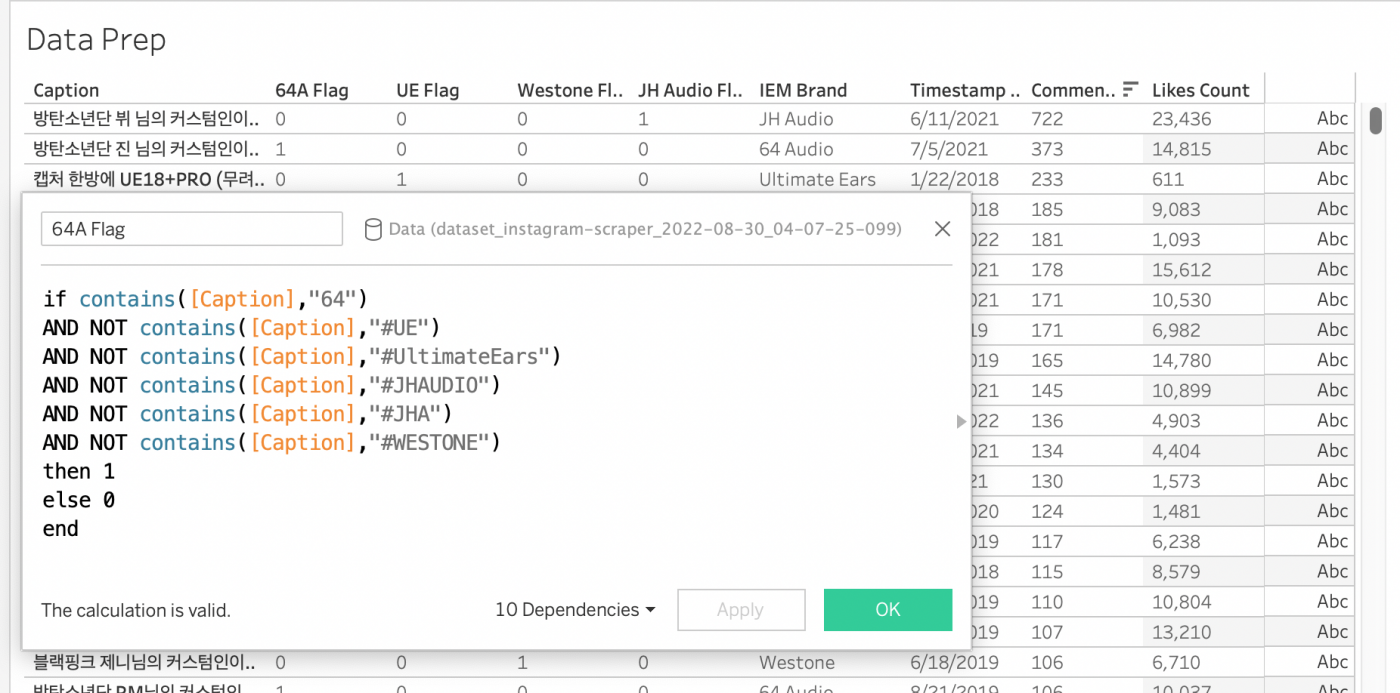
The data was read into Tableau, where the next goal was to isolate posts by the brand that was being featured. SoundCat has four brands that they retail: 64 Audio, JH Audio, Ultimate Ear, and Westone. This meant creating flags for each of the four brands based upon key words. Now, this is a good point to outline some assumptions that have to be made on the data:
- The poster uses a brand hashtag when posting about an IEM.
- The brand hashtag used by the poster corresponds to the actual brand of the IEM.
- The key words that I selected are representative, and contain, all the hashtags being used by the poster for a given brand.
- SoundCat makes a post for every IEM they sell to artists and is not favoring certain brands when posting.
Some edge cases were as follows:
- Some posts might just be general marketing posts. What if there is more than one brand featured in a post?
- Some posts might not be focusing on IEM brands but the artists themselves or an in-store event. What if there are no brands in a post altogether?
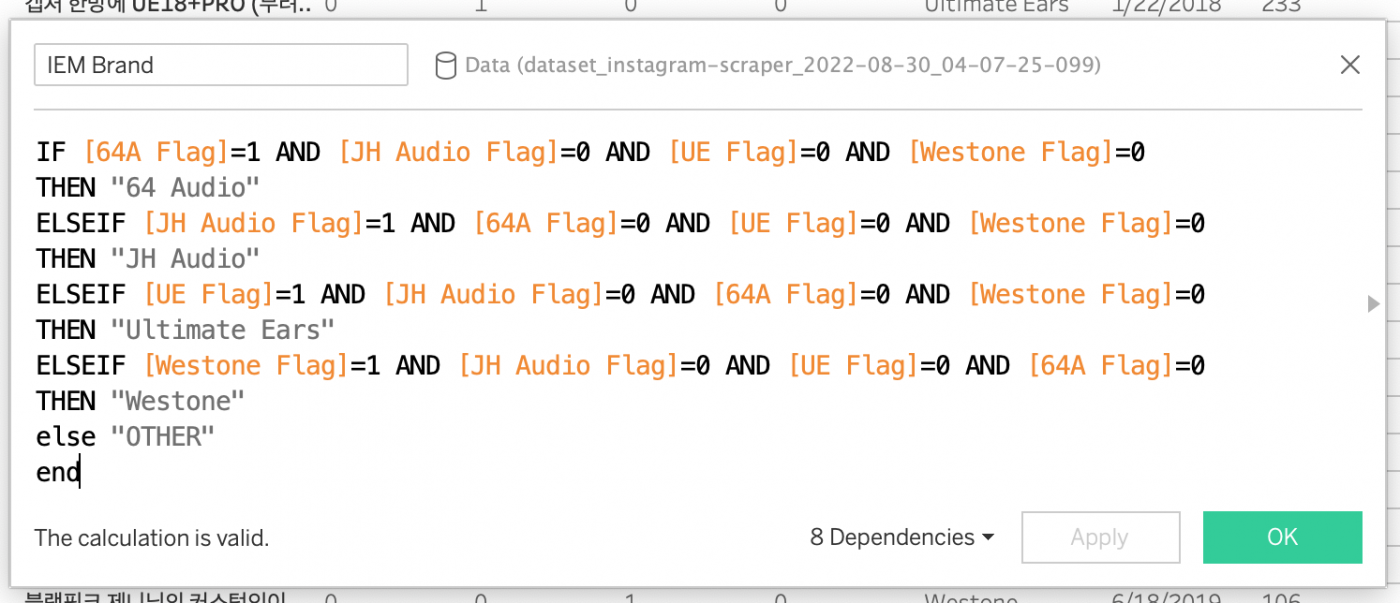
I addressed the edge cases by assigning individual brands based on the flag, and the “OTHER” string to any posts that contained more than one brand flag or that didn’t contain any flags altogether. Then I applied a filter on the data to exclude brands with the “OTHER” string; this resulted in roughly 20% of the data being removed and bringing it to n=1611. With the data cleaned, it was time to get down to some analysis.
There's not much to this part - it's a lot of dragging and dropping, and just playing around to make the data look pretty. There was also some grunt work involved because I couldn't think of a way to sort through the captions to get the names of the top idols. If I find a comprehensive list of idols and groups, I could possibly scrape it and make another calculated field to assign them like I did the brands. But this would be difficult given that groups also have fandom names and SoundCat might use Korean hangul interchangeably in their hashtags.
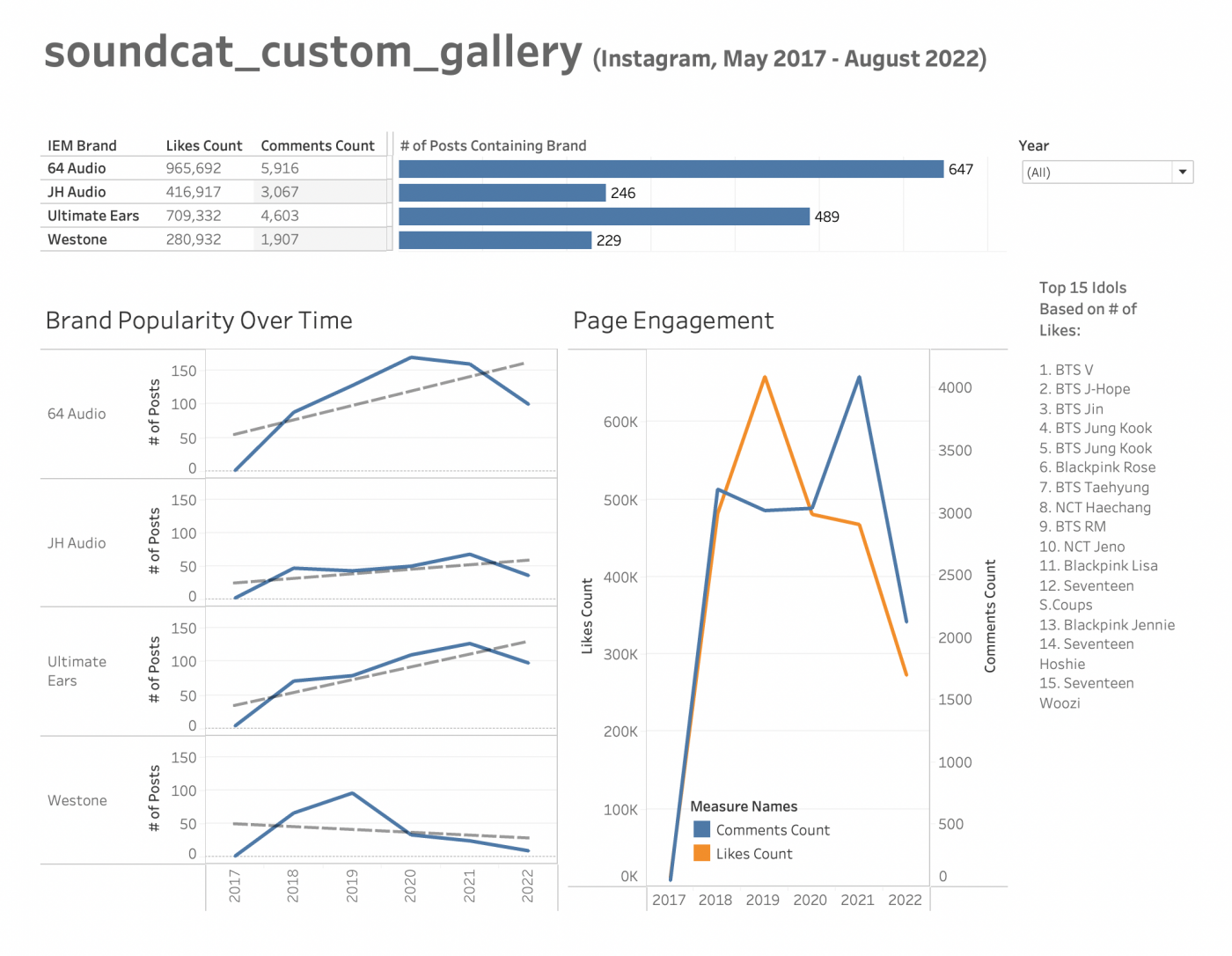
Data prep can be viewed here if, for example, you're keen on digging through manually and finding out which posts/artist had the most comments. The link to the visualization above is also here.
Some general takeaways:
- There are basically two clusters. 64 Audio and Ultimate Ears are performing positively by most metrics such as likes, comments, and number of posts; JH Audio is underperforming and Westone is declining. We cannot completely draw conclusions for the year 2022 because it's still only August. However, we can use a linear regression (which is depicted by the dotted lines in the bottom left) to get a general feel for the trend.
- The idols that receive the most likes for their CIEMs are more or less the idols you'd expect relative to their popularity. BTS, Blackpink, NCT, and Seventeen are the most popular with a decent margin going to BTS as a group:

Image source: Billboard
On the IEM side, I would say that these results are also mostly what I would expect based on my industry knowledge and experience with these brands. Westone is a brand that is generally considered to be not-so-progressive. JH Audio is a stagnant brand that likewise isn't exactly known for their great tuning choices. 64A is generally considered a top brand even in the audiophile world because of their unique technologies and solid tuning. However, it's somewhat surprising that Ultimate Ear's IEMs are still a strong contender. I actually have not heard an Ultimate Ears IEM yet (surprisingly so, given the 300+ IEMs I have heard), but they aren't the subject of much talk in the audiophile world.
How can we glean more insight?
But of course I wasn't satisfied with just looking at likes and hashtag data. My next approach was to scrape images from SoundCat's posts and then use a Python library like PyTesseract to derive text information from them. Again, there are some assumptions that have to be made on this data like the correct descriptions being in the text and that whoever's posting isn't favoring certain brands. There's also the possibility that PyTesseract won't correctly scrape some information if the photo is too blurry, the background is obfuscating text, or Korean hangul is being used.
I'd say that about 75% of the work in data analysis comes down to data manipulation and cleaning. This is not fun, so I won't bore you with all the fine details. What it basically came down to was the following:
- Ponying up a $10 ransom to Inflact to download SoundCat's photos and waiting the whole day for them to be downloaded.
- Discriminating between the first photos and subsequent photos in a given post by setting a threshold for which ones to keep based on the image file size.
- Running them through PyTesseract's image_to_string() function to pull all the text data, and discarding images where no text was pulled.
- Performing cleaning on the text data to segregate the date, artist, IEM, and brand.
If you really want to take a look at my scuffed code (no seriously, I basically just Stack Overflow and copy-and-paste everything), then you can check out this link to the workbook.
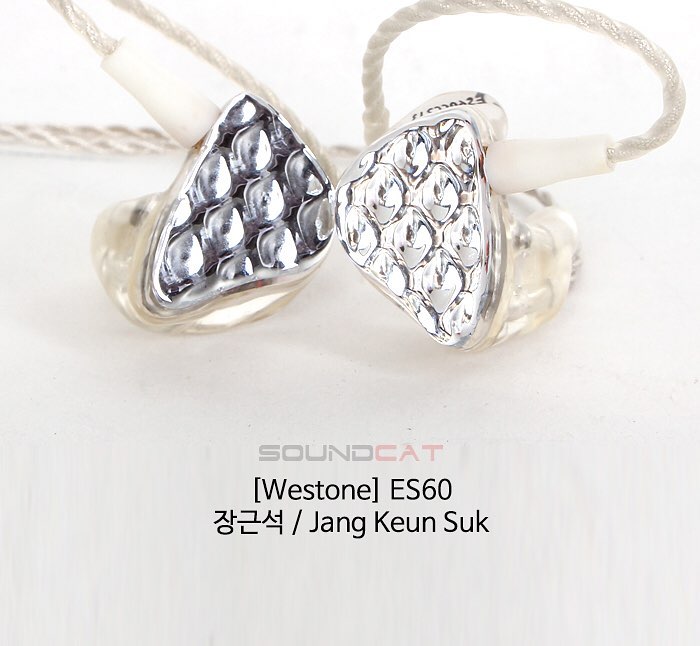
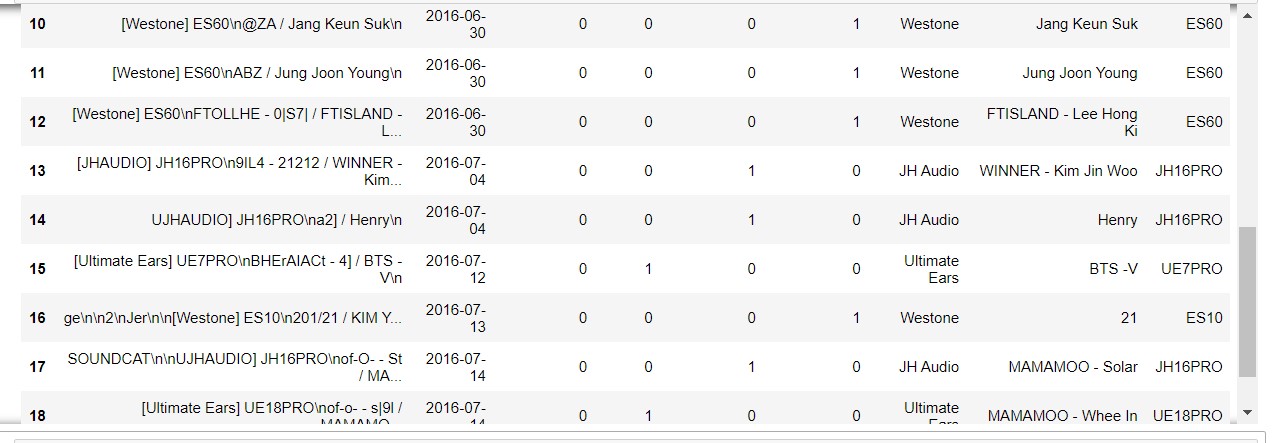
The end result? Going from all the pictures you see on the Instagram profile to the dataset of n=1517 entries above.
Once I had my cleaned dataset, it was all about plugging it into Tableau again and seeing what I could derive. Something I took the liberty of adding is a field for the price of the IEMs. As a caveat, these prices are definitely not completely accurate. Some of these IEMs are discontinued, and prices are often for the base model prior to customization options!
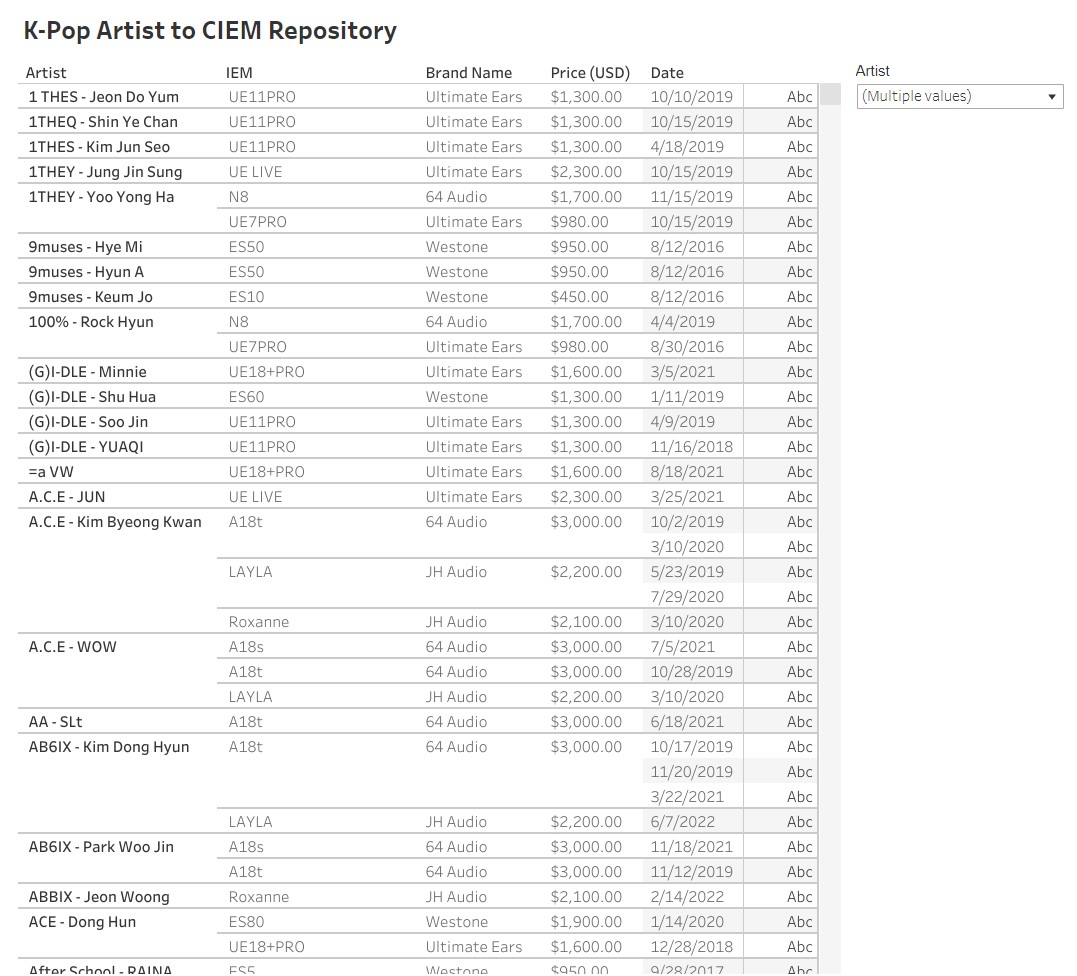
One of the most simple - but powerful - use cases for this data is creating a repository where users can lookup an artist and their corresponding CIEM(s). You can view and use this repository here. You'll notice that many artists, especially the more popular ones, have multiple CIEMs! I suspect that this is mostly a product of "upgrade-itis", but it's worth pointing out that ears also change shape over time. This can necessitate a re-fit, and sometimes it makes more sense just to upgrade to a new CIEM.
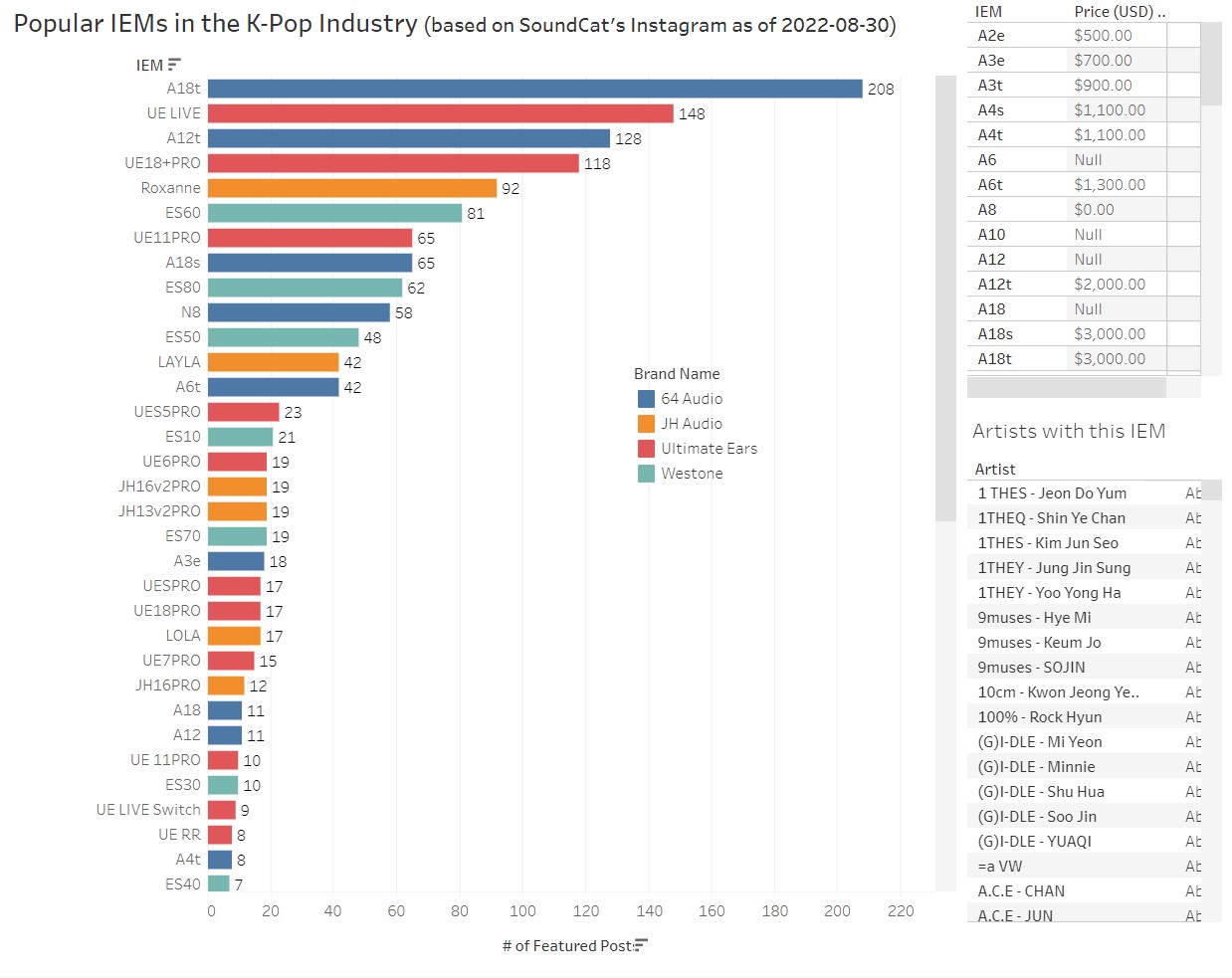
Something else that can be analyzed now are individual IEM models and how they rank in terms of popularity. You can view this here, where clicking the bar of the IEM will also reveal which artists have the IEM. For a more granular view by specific brands, you can see this here.
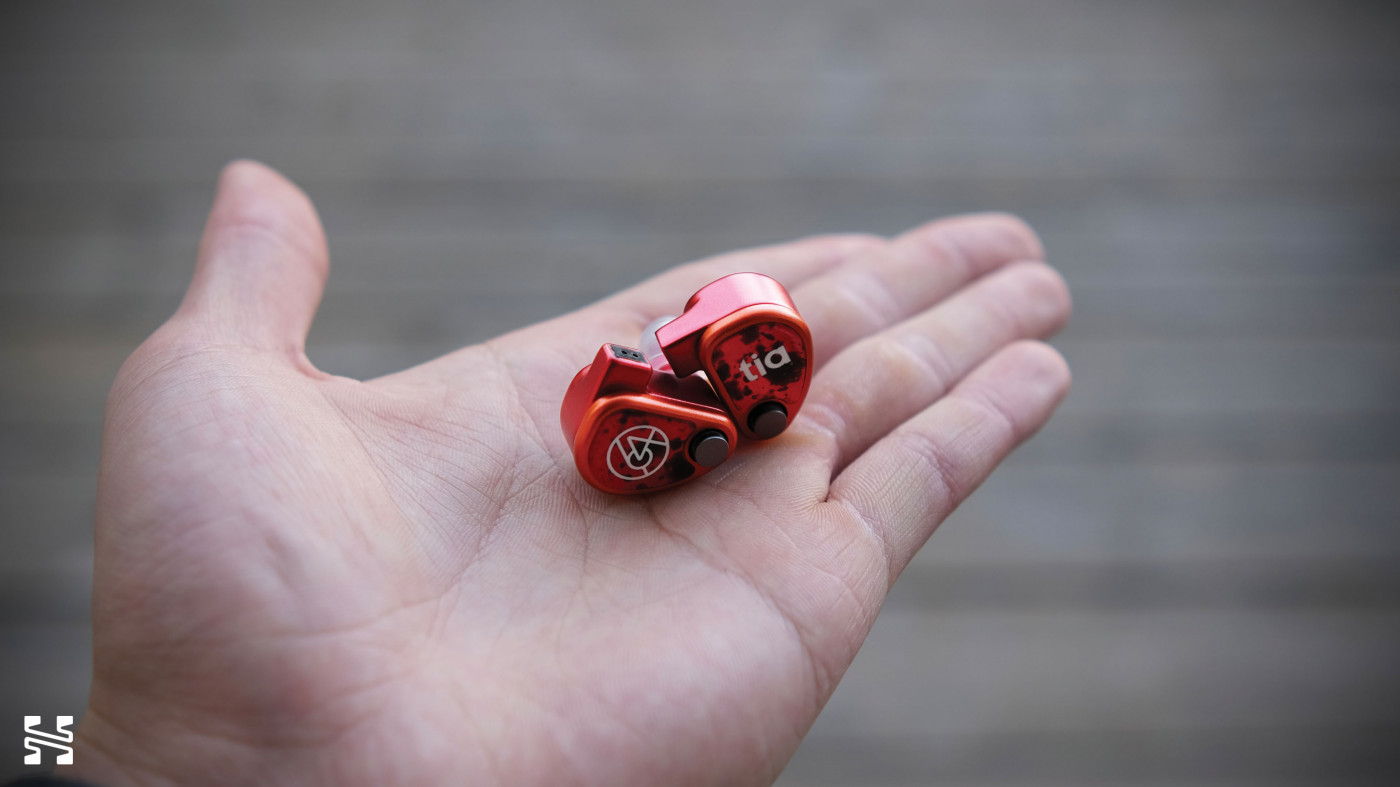
This is the U18t, the universal version of the A18t. CIEMs are molded to their owner's ears, so others usually can't wear them comfortably. This is where universal IEMs which can be worn by anyone come in.
Anyways, wow! I was not expecting the A18t to be the top IEM. Frankly, I'm much more partial to the A12t (which I own in its universal form, the U12t). It's even more surprising when you consider that the A18t is a $3000 IEM. The numbers for the A18S - the A18t's brother model - clearly aren't as good, but it was just released in 2021; taking the time frame into account, it seems fairly popular as well. Generally, we can infer that not only do K-Pop artists like expensive IEMs, but fans - who often sponsor the purchase of IEMs for artists they support - also have some deep pockets! The strong presence of the UE Live and UE18+ Pro is also another indication that I should get my ears on a UE IEM soon.
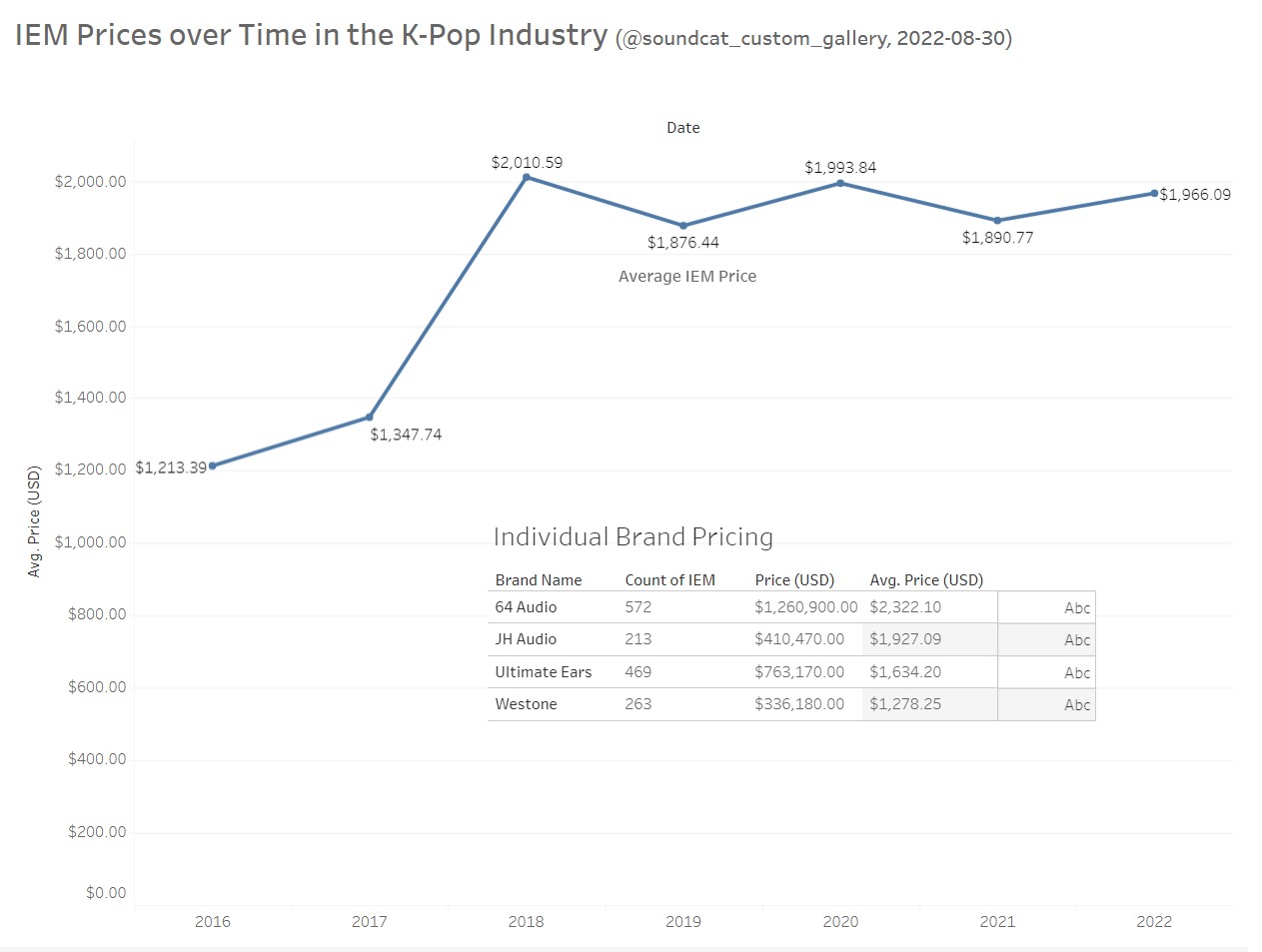
Here's a look at some more pricing data, just to illustrate how expensive some of these IEMs can get. Note that there is a strong increase in prices in 2018; this might be attributed to the very expensive 64A A18t being released in 2017 and picking up popularity. But as crazy as it sounds, I would say that prices for CIEMs in the K-Pop industry are fairly consistent, almost reasonable compared to the state of the audiophile world. On the audiophile scene, prices regularly shoot past $3000 and have only continued to soar. This is one of the issues with the audiophile scene: products are often hype-based and cyclic; there's a general lack of stability to the market. Juxtaposed to the consistency of the pro audio industry shown in the graph above, it's no surprise that many manufacturers want in on this market segment instead.
But how do IEMs actually sound?
Now this is a loaded question. Perception of sound is highly individual (see HRTF) which makes it difficult to pin down how an IEM will sound to someone subjectively. Furthermore, IEMs themselves have many individual "flavors" of sound, equal parts a product of tuning ineptitude and to appeal to the wide range of listener preference. Generally speaking, this means that even mega-expensive IEMs can range from sounding like "Holy cow, this actually sounds like it's worth two grand" to "Holy cow, my Apple AirPods sound better than this".
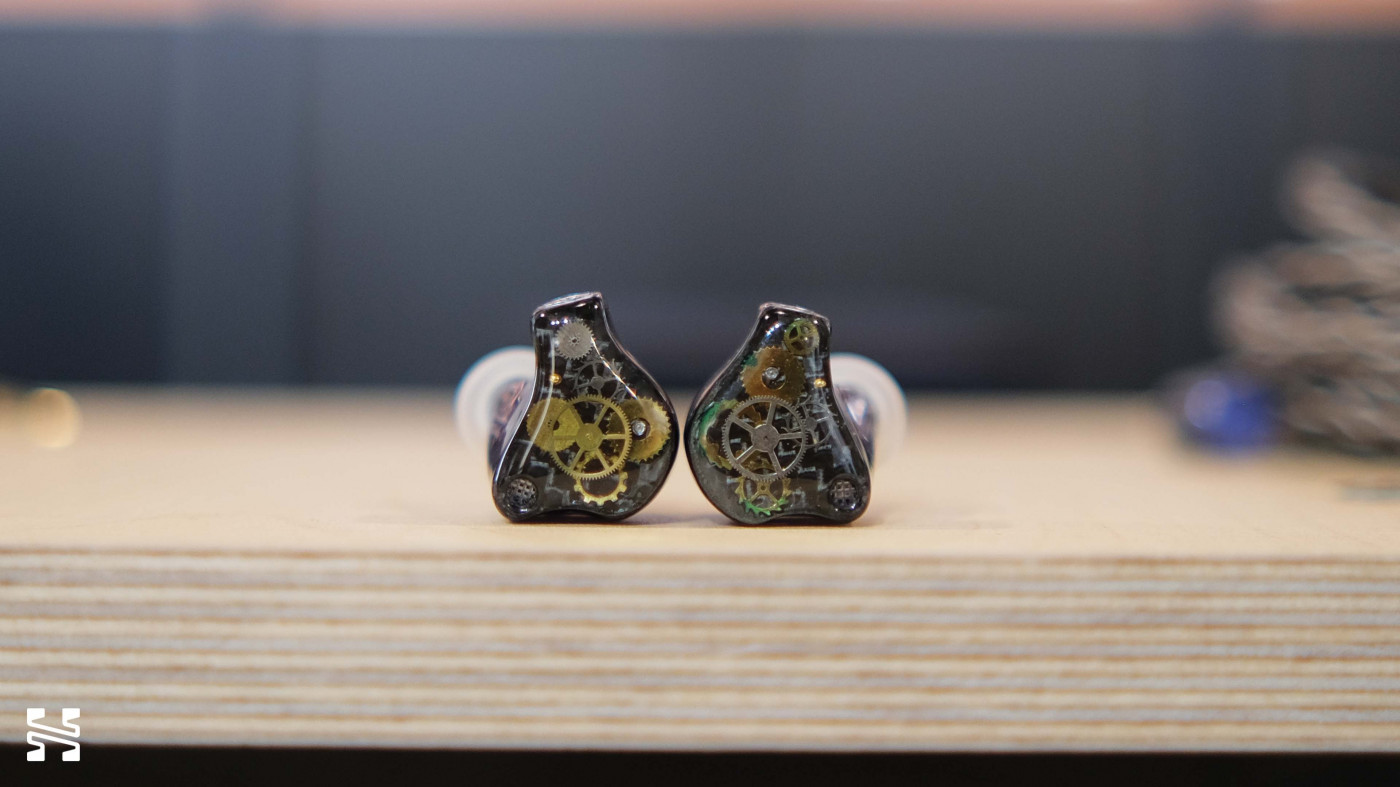
Although I don't think there's any dispute that IEMs usually look way cooler.
Given this ambiguity, luckily, there is objectivity in the form of frequency response measurements which depict the relative loudness of an IEM at each part of the frequency spectrum (in layman's terms, think bass, mids, and highs). With experience, listeners can get a decent idea (read: still no substitute for actually hearing an IEM in-person) for how an IEM will sound by consulting the measurements. There's a lot of other caveats to measurements (see here for some), but this is just the high-level overview.
Below, I'll pull an IEM from each brand that I feel is most representative of that brand's house sound to illustrate what you can generally expect to hear. In the measurements below, you can think of the dotted line as what would produce a "neutral" sound (although the idea of a universal neutral target is silly given what I've outlined in my preamble). In any case, I find that the dotted line is still mostly representative of my neutral sound. Measurements are sourced from Crinacle's site, as he has a much larger database than my own, especially when it comes to IEMs from these brands.
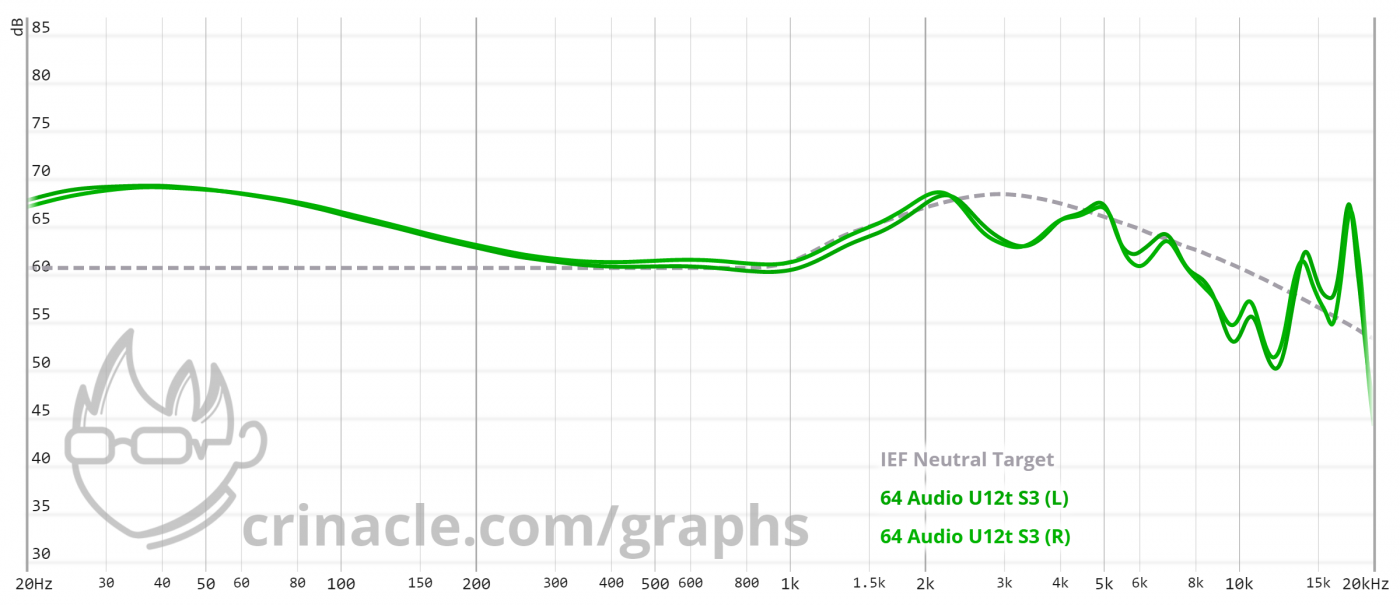
The U12t has a U-shaped sound signature with boosted sub-bass and upper-treble. Its bass is clean and impactful due to the shelf coming down at ~200Hz but being tastefully elevated. Generally, its midrange will sound more pulled back and relaxed because of the recession from 2-4kHz. Its treble, however, can be somewhat splashy and bright for some listeners while boosting detail (the U12t sounds extremely detailed). The recession at 2-4kHz and at 8-14kHz begets a strong sense of staging wherein there's a lot of airy, open space between instruments. Subjectively, I would say this is one of the best-sounding IEMs I have heard.
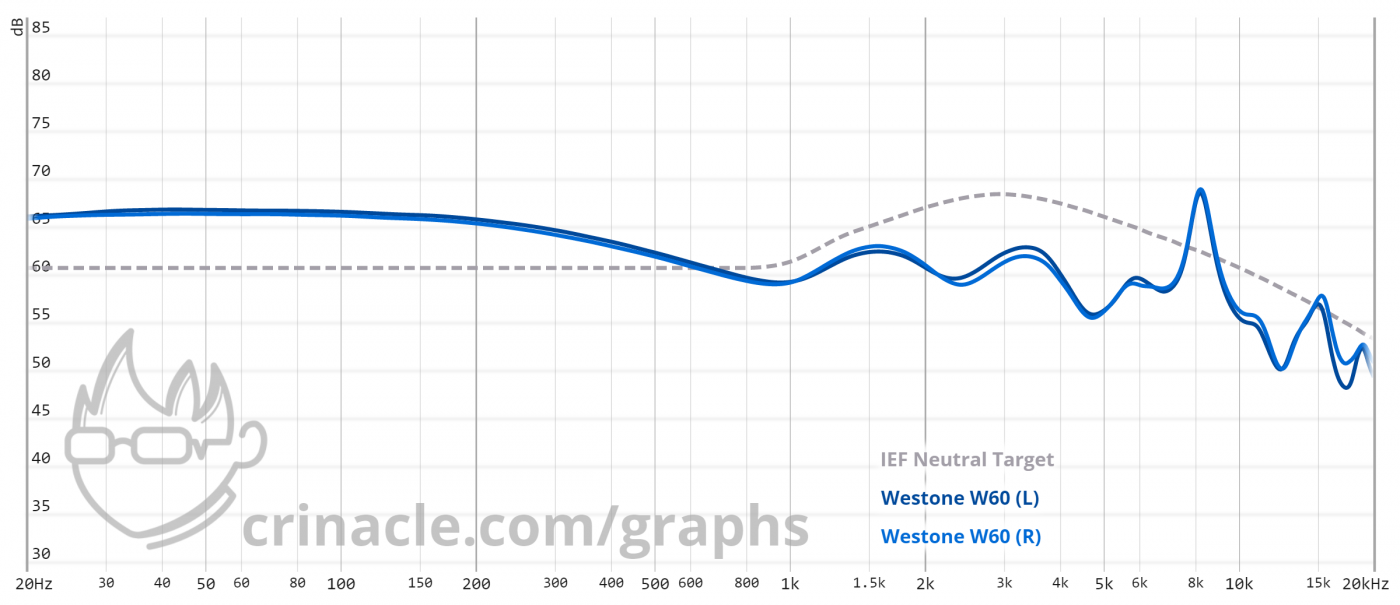
It's hard to make sense of the W60's sound signature. The bass is quite boosted, to the point of which it interferes with the lower-midrange frequencies and lends to bloat. On the flip side of the coin, the W60's upper-midrange and treble frequencies are mostly non-existent (observe the differential from 1.5kHz to 6kHz compared to the IEF target). The end result is a very dark, congested type of sound that would not appeal to most listeners' preferences.
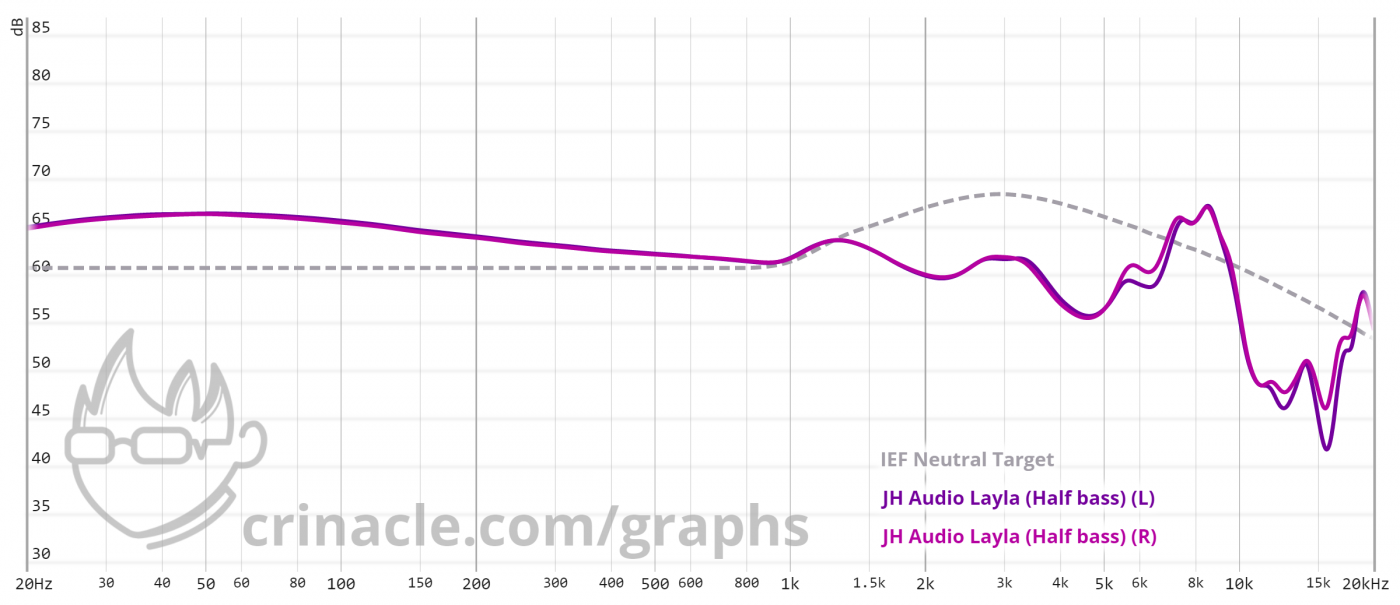
The Layla shares similar characteristics to the W60 from the bloated bass to the sucked-out midrange. However, the Layla does exhibit a treble peak at roughly 7kHz which is a distinctive characteristic of many JH Audio IEMs. This can make it sound somewhat harsh while (in theory) probably giving it better perceived detail than the W60 above. Subjectively, though, I struggle to recall which one I disliked more when I heard them.
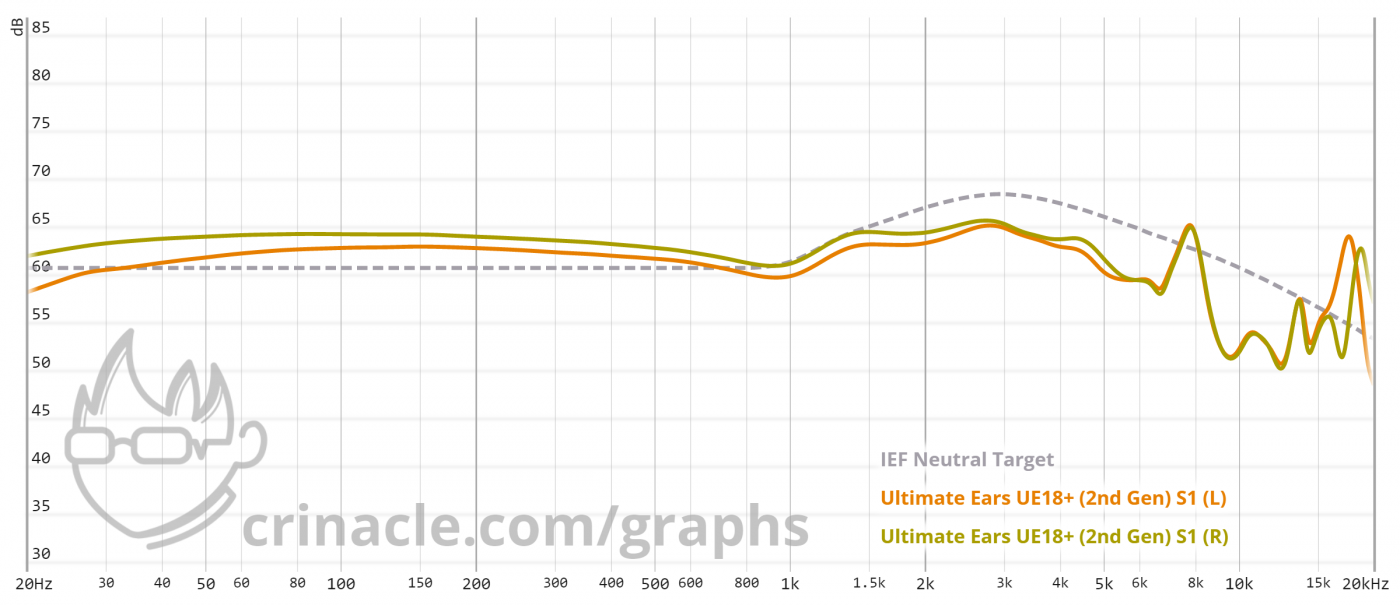 The UE18+ has a mild bass boost but not to the point of which it would bleed significantly and impact midrange clarity. This is aided by the structure of its upper-midrange, which is more relaxed, but certainly not egregiously such as with the W60 and Layla. Interestingly, the UE18+ seems to have a decent amount of energy past 15kHz, which suggests that it has good treble extension like the U12t. On paper, the UE18+'s frequency response suggests a somewhat exciting, but still fairly close to neutral sound. Basically: it looks like it'll probably sound very good, and I'd like to hear it one day.
The UE18+ has a mild bass boost but not to the point of which it would bleed significantly and impact midrange clarity. This is aided by the structure of its upper-midrange, which is more relaxed, but certainly not egregiously such as with the W60 and Layla. Interestingly, the UE18+ seems to have a decent amount of energy past 15kHz, which suggests that it has good treble extension like the U12t. On paper, the UE18+'s frequency response suggests a somewhat exciting, but still fairly close to neutral sound. Basically: it looks like it'll probably sound very good, and I'd like to hear it one day.
Love our in-depth reviews?
We test and review hundreds of headphones every year. Sign up to get the latest news, reviews, guides, and more in your inbox. Join the 60,000+ like-minded audio lovers who love our newsletter!
Enough analysis, more eye candy please
Okay, even I'm getting tired of looking at all these graphs. And I can't lie, the other reason why I performed the analysis in the first place is so that I would have an excuse to gush over some of my favorite artists and their music in an article!
Dreamcatcher
In order of appearance: JiU, Siyeon, Yoohyeon, and Gahyeon
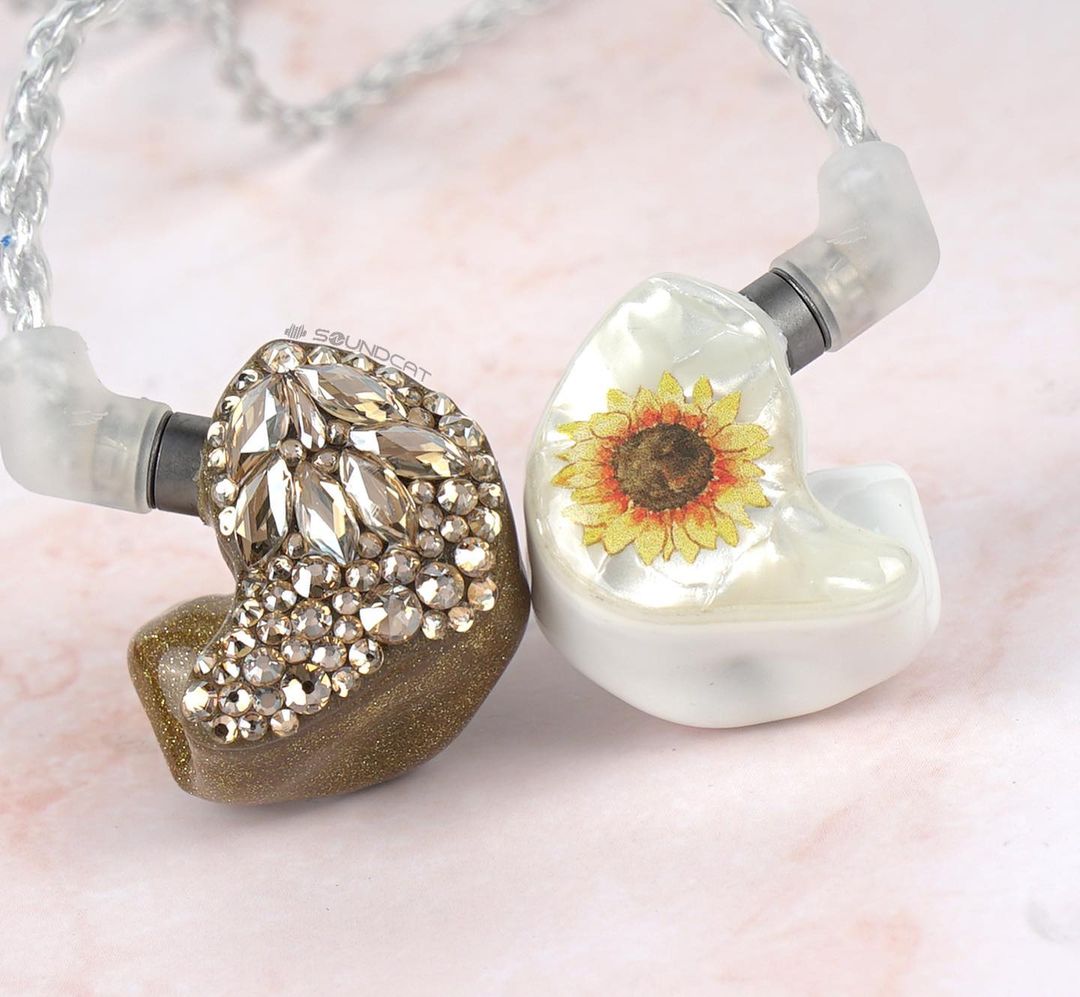
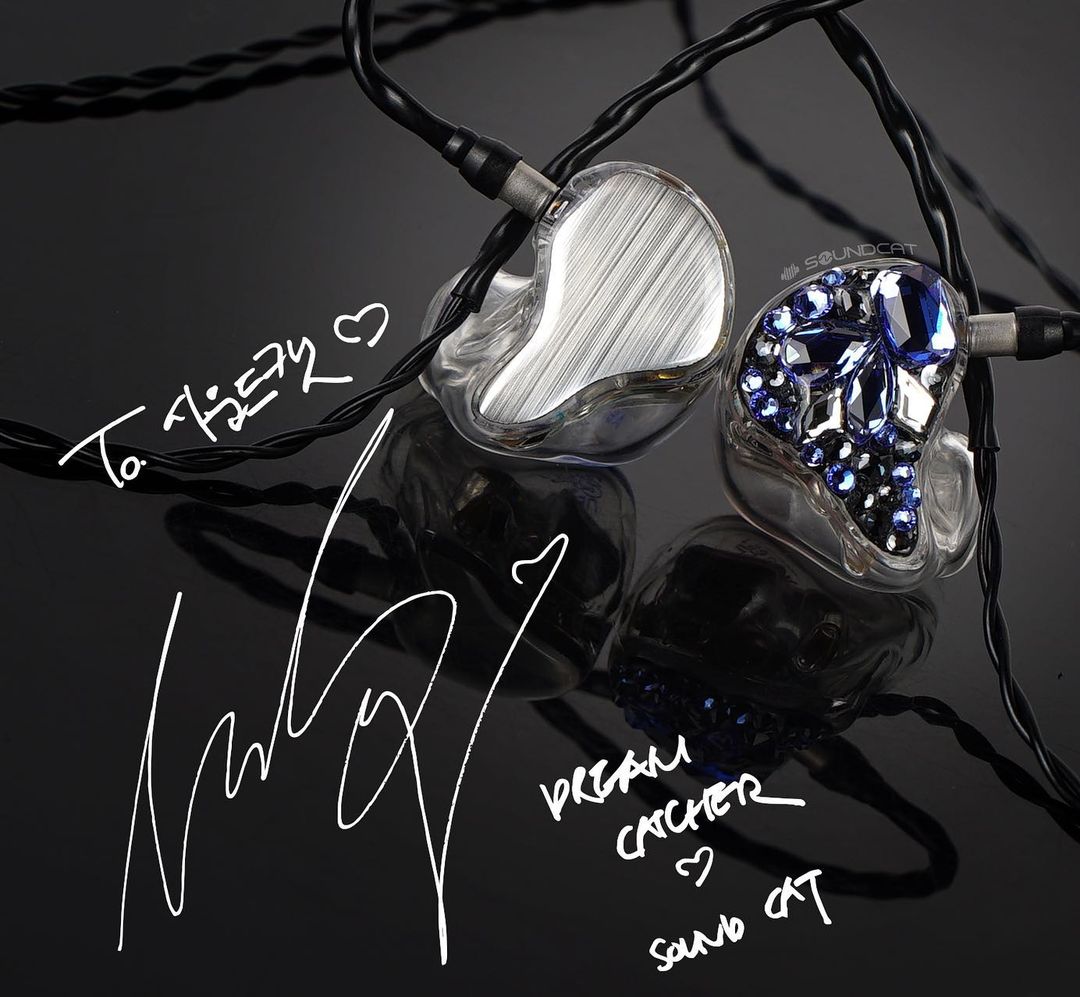
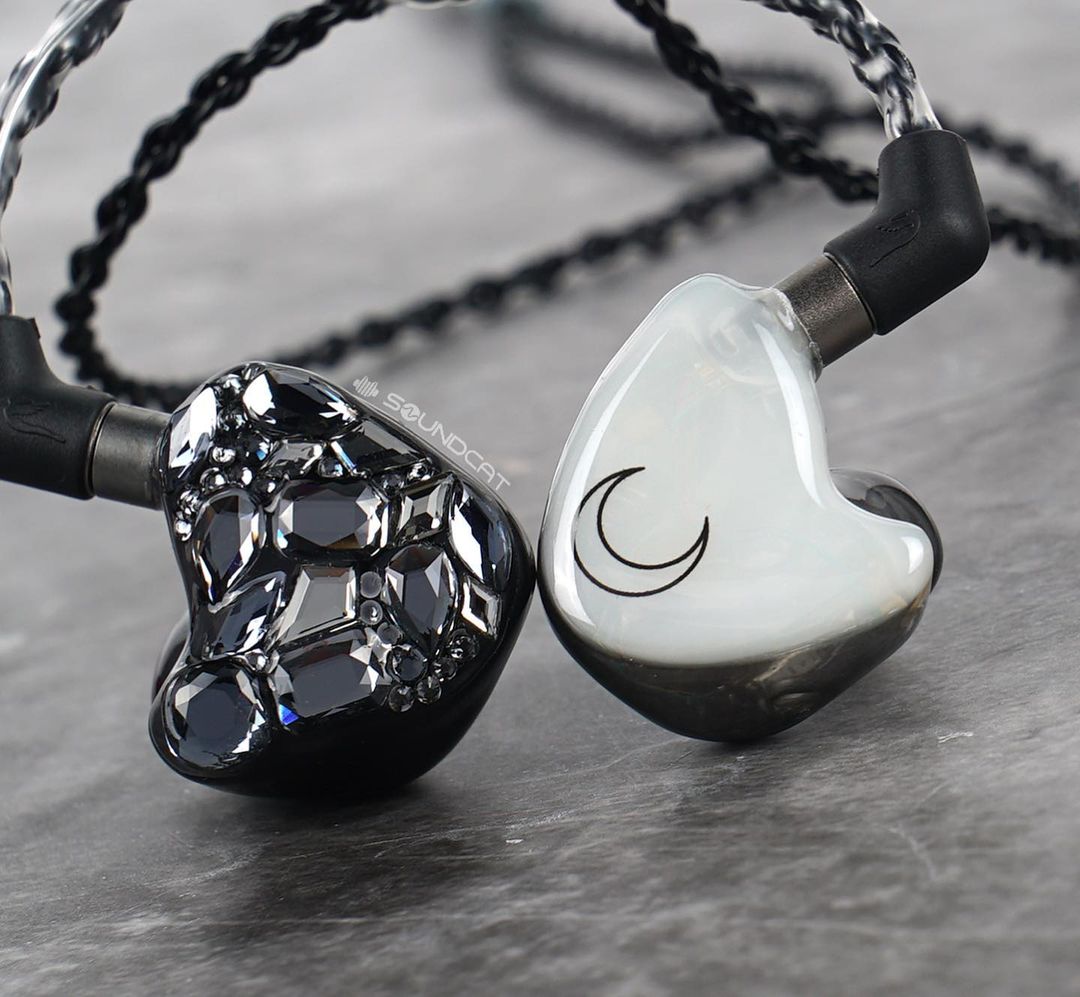
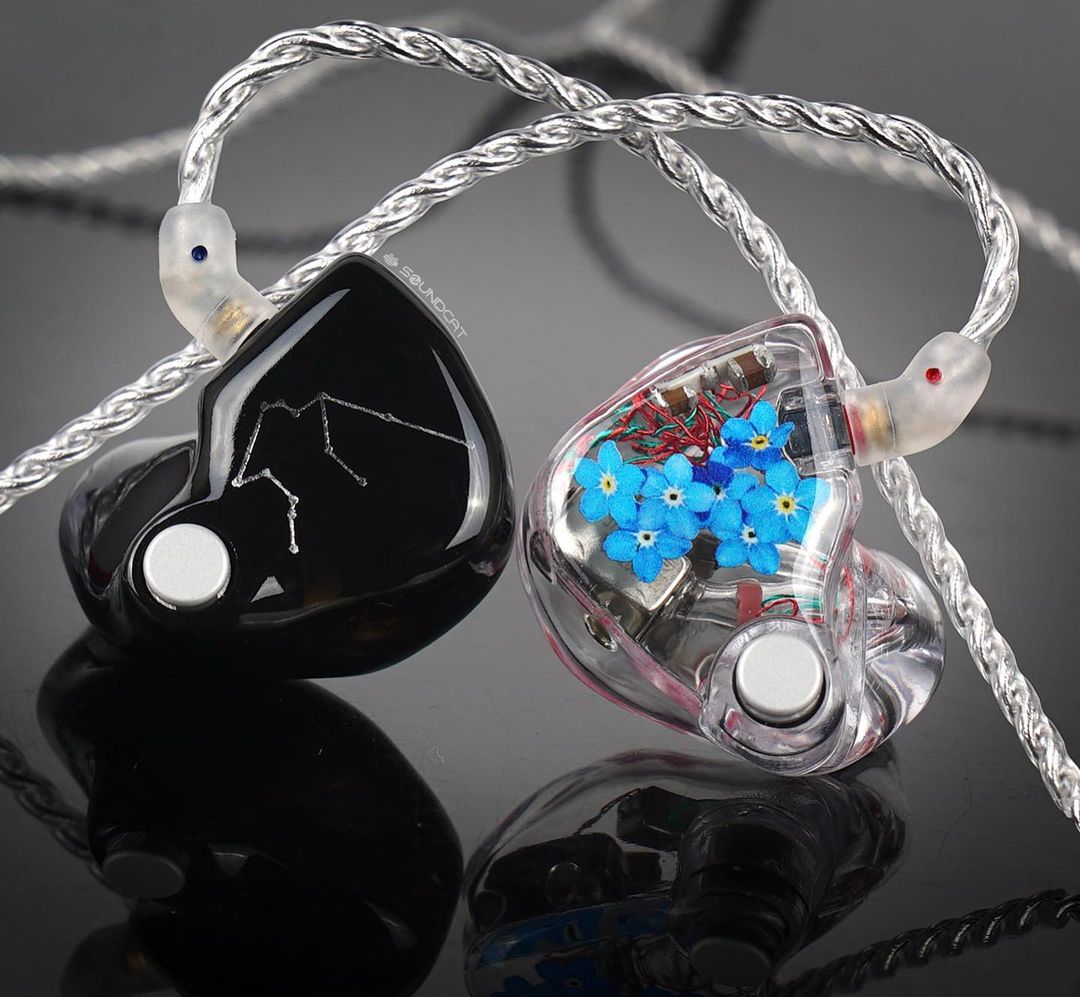
I wasn’t able to find all the members’ CIEMs, but right out the gate we see quite a lot of variety in this lineup. JiU, the group’s leader, has gone with the JH Audio Layla which looks great and sounds equally awful (sorry!). Yoohyeon has the JH16V2 Pro which basically falls into the same book. I haven’t listened to the UE Live which Siyeon uses. And finally, Gahyeon has the 64A A6t. Knocks against sound-quality aside, I think all of these IEMs look awesome; it’s readily apparent that each member put a lot of thought into customizing them.
Dreamcatcher’s discography is distinct from most K-Pop in that it follows a more rock-inspired sound; however, most of my favorite tracks from them tend to be more of the EDM persuasion. If I had to choose a favorite track, it would probably fall between “Silent Night” from Raid of Dream (2019) or “BOCA” off of Dystopia (2020). “Silent Night” is bass-y and slightly dark up-top, whereas “BOCA” maintains the dark tone but tends to sound more aggressive due to the addition of some electric guitars and more backdrop minutia.
IU
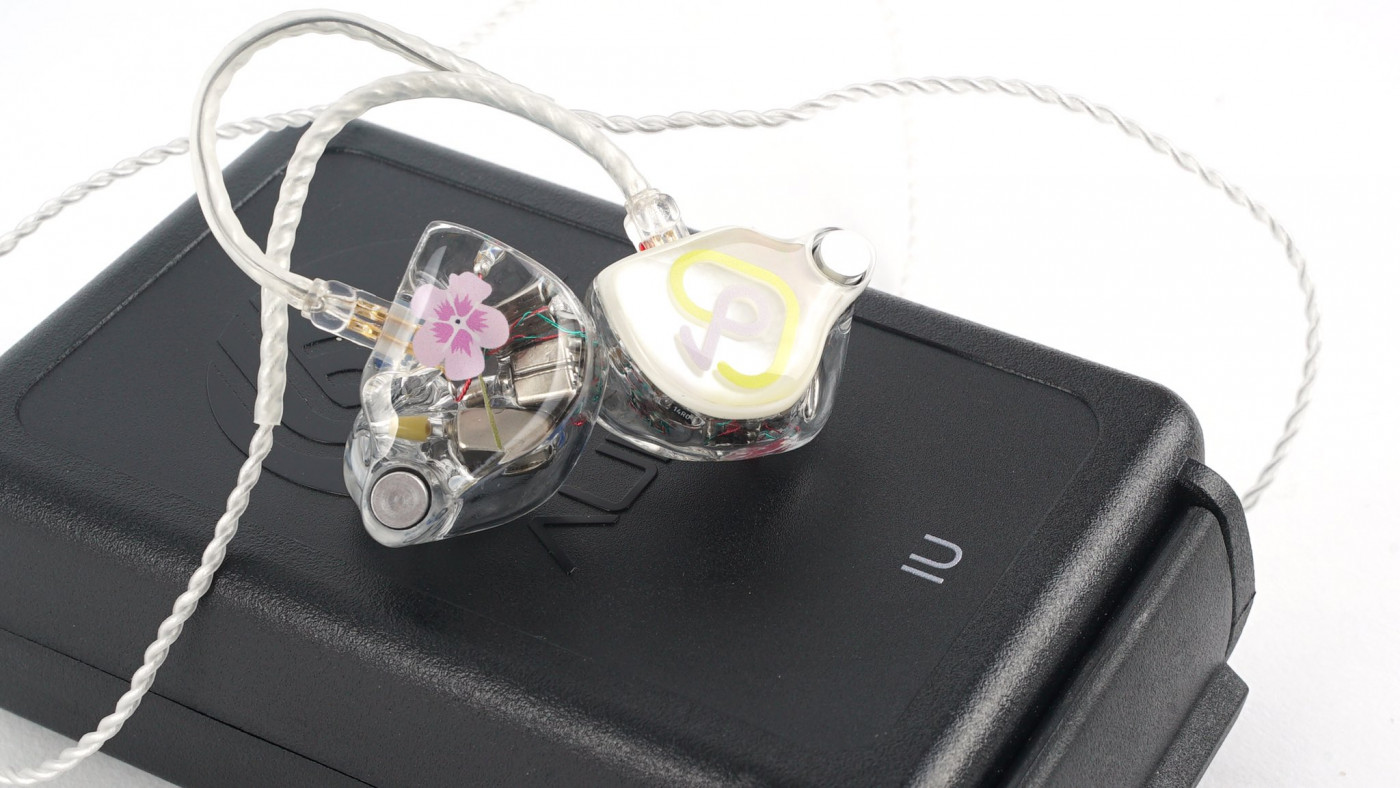
Image source: 64 Audio
IU primarily uses a 64 Audio A12t. The flower on the clear background is something that seems to be quite popular with CIEMs; I’ve even chosen to do something similar with my own 64A A3t. On the right faceplate, we see mother of pearl and another custom artwork (I’m not sure what this symbol is, maybe someone can comment). This is the old case that 64A included with their CIEMs; it's been deprecated for an aluminum hockey-puck case.
Although I was not able to find an individual photo of it, IU also owns a Westone CIEM which can be seen in some photos:
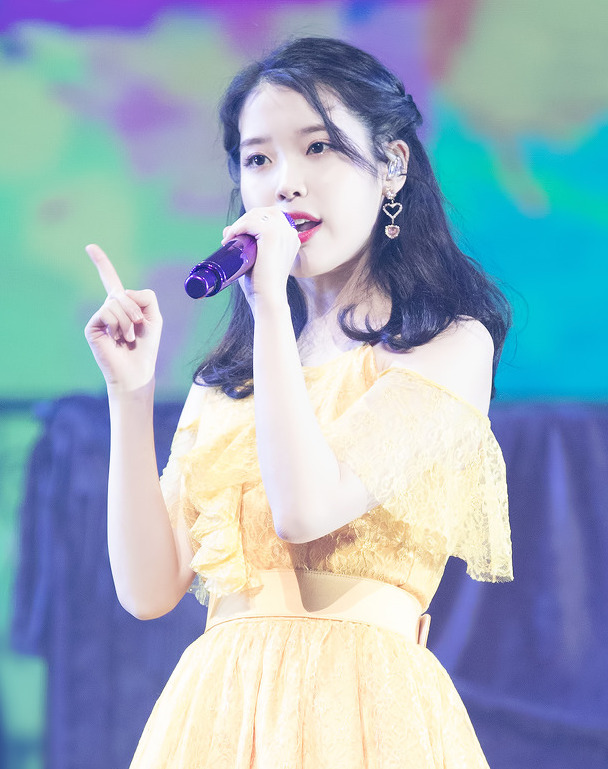
Image source: Wikiwand
IU is an interesting singer. As a possible trigger warning, I don't think she is the most skilled vocalist (at least compared to the best vocalists in K-Pop). However, I do feel that she is very consistent as an artist, alternating between pop-oriented tracks (which tend to be my preference) and slower, ballad tracks. Her voice is generally best described as being slightly peachy with a smooth taper to the way it decays. “Blueming” off of her Poem (2019) album remains a personal favorite; in fact, it’s the song that piqued my interest in the K-Pop genre in the first place. On this track, the drum machines are heavy and present, the side-to-side pans on the drums are quite fun to follow, and IU herself is infectiously upbeat.
Loona
In order of appearance: HeeJin, Kim Lip, Chuu, YeoJin
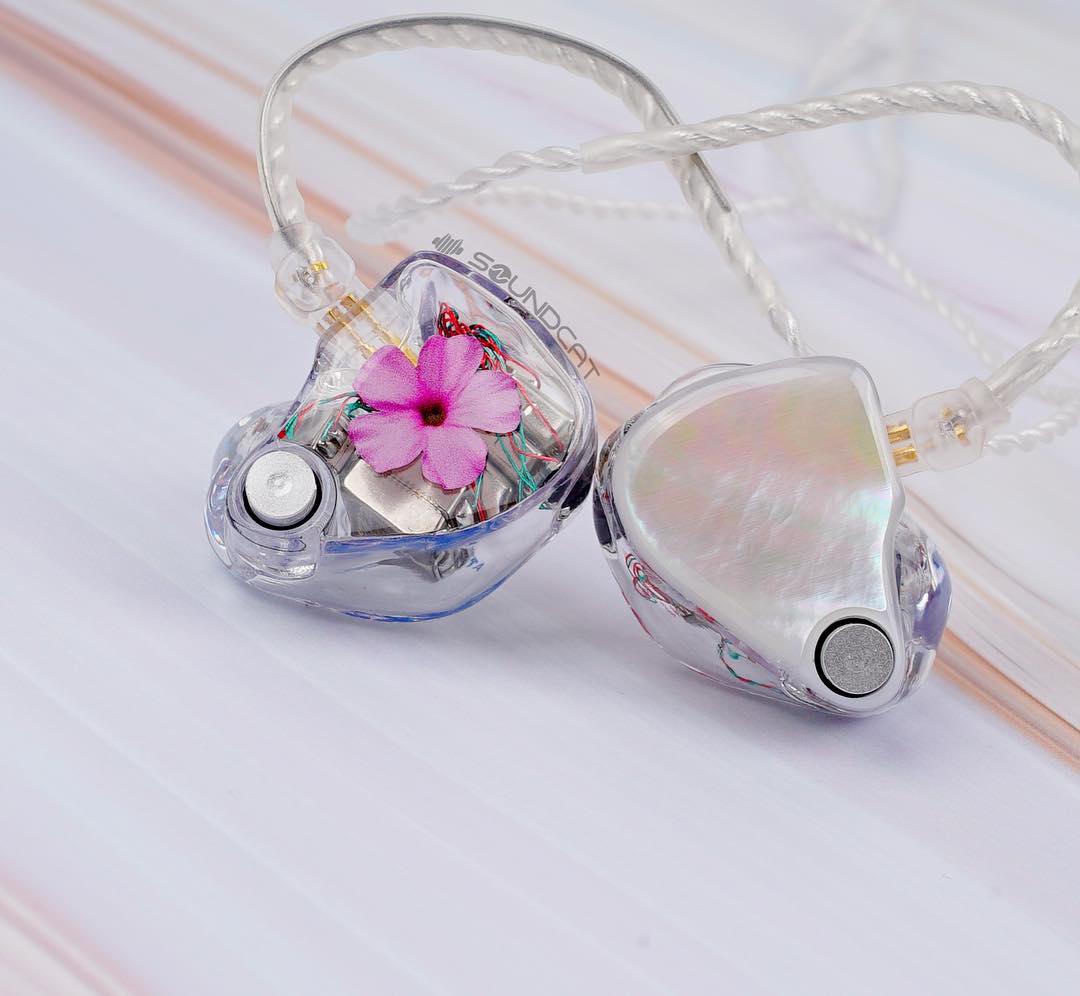
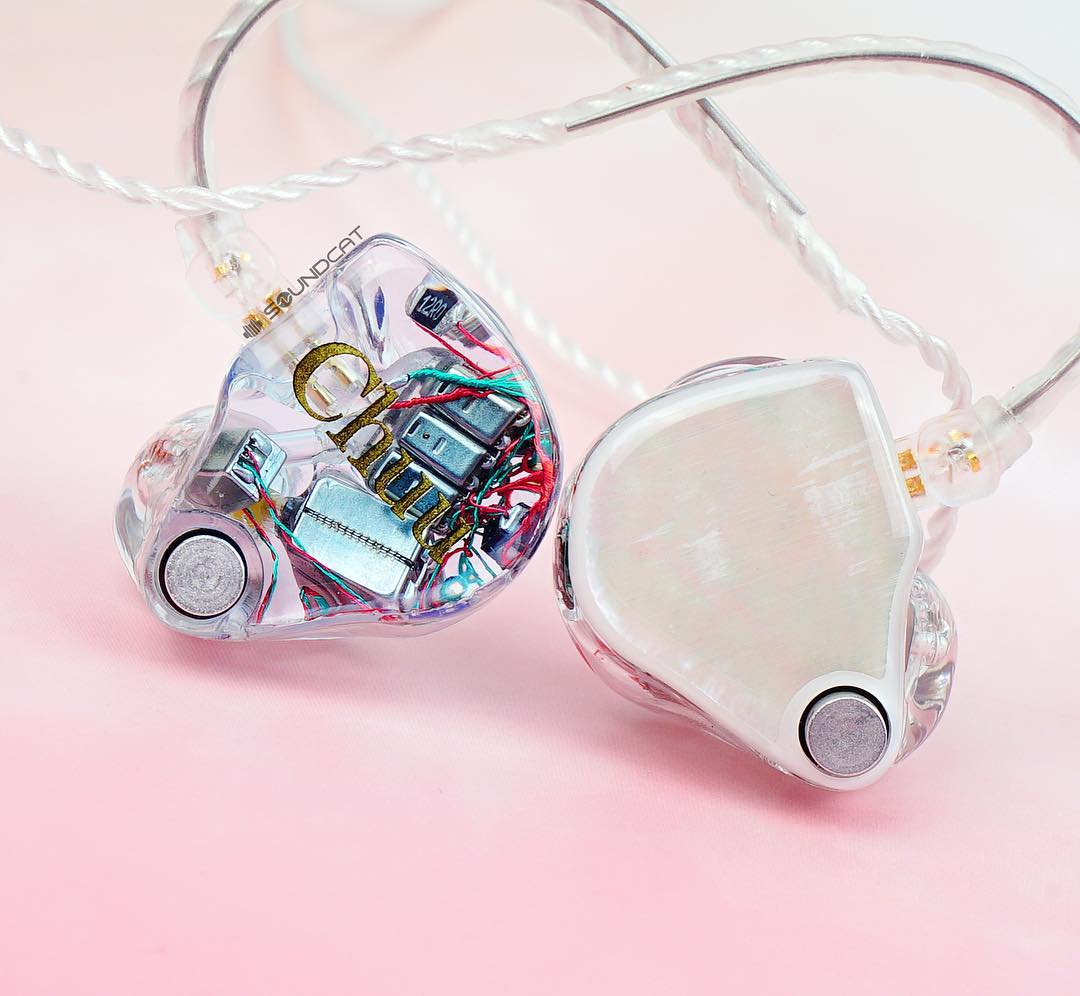
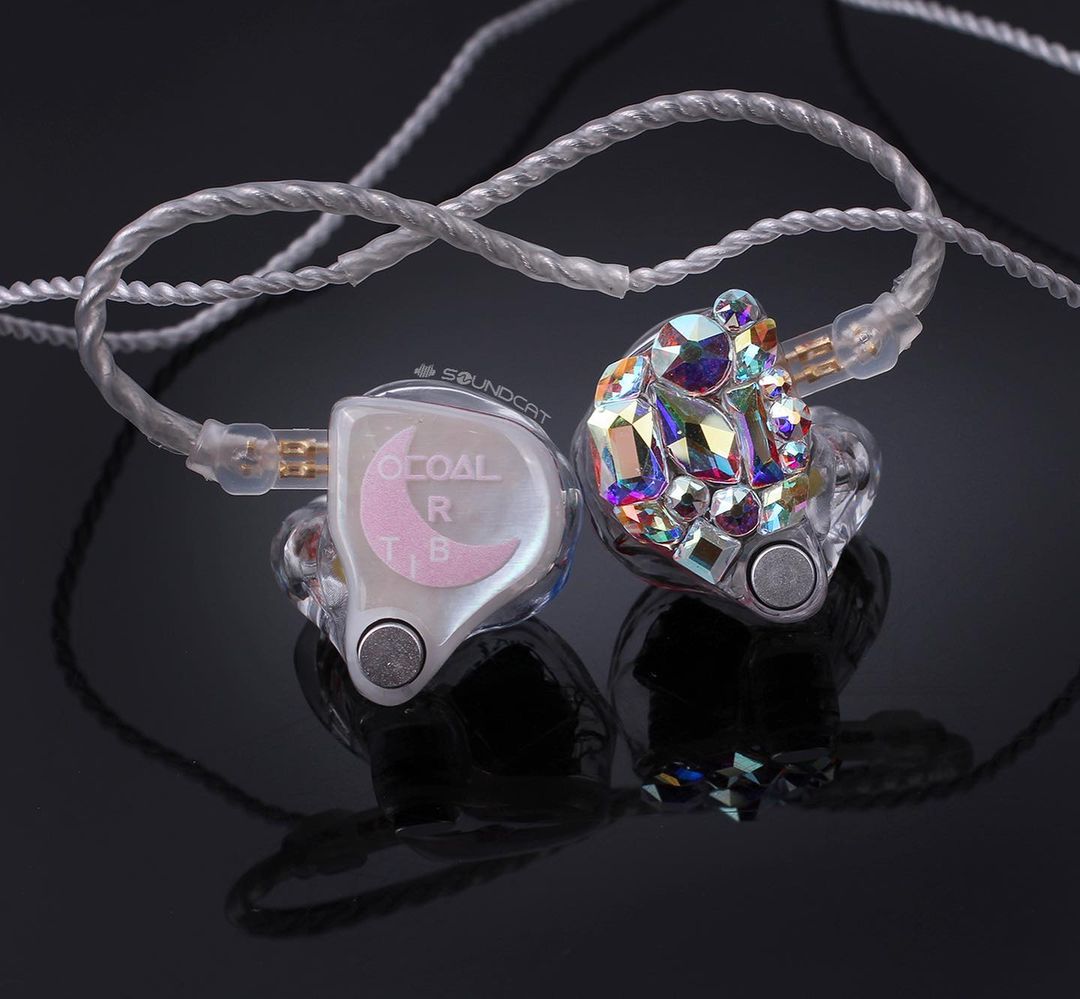
As a group, Loona predominantly uses the 64A A12t, although there are some other odds and ends mixed into this group of twelve that I wasn’t able to locate. Most readers of my reviews already know my thoughts on this IEM: still one of the best sounding IEMs on the market today, at least in the universal version, as the CIEM tends to sound slightly warmer. Out of this lineup, I’d say I’m most fond of Heejin and Chuu’s faceplate designs. There’s a decent amount of variety in these designs, but a common denominator seems to be the use of the mother of pearl faceplate.
Musically, I would attest that Loona is one of the most consistent girl groups on the scene. Their earlier discography specifically has excellent production quality even if some of it was more experimental in nature. I’m particularly fond of their XX (2019) album and the tracks “Butterfly” and “Where You At”. The attention to detail is obvious on Butterfly even if I find the drop underwhelming. Generally, one of the prime strengths of these tracks is that they make excellent use of vocal overdubs and fading high notes in tandem with airy drum machines and snares. The tracks sound delicately crafted, almost ethereal in presentation. “Voice” off their 12:00 (2020) album generally maintains this spirit with a darker atmosphere.
Taeyeon
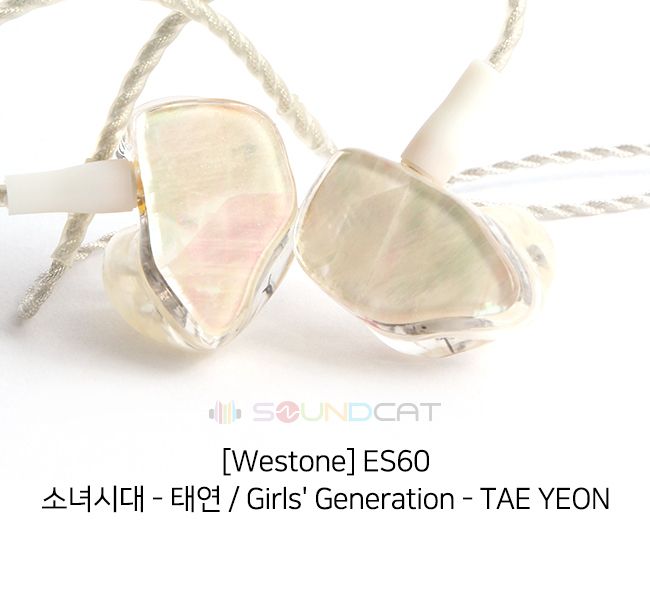
It appears that Taeyeon has gone through a couple generations of the Westone IEMs over the years, starting with the ES5, upgrading to the ES60 with a red faceplate, and then swapping to another ES60 (the one pictured above) with the mother of pearl faceplate. The ES60 is a 6BA IEM that uses MMCX connectors. As someone who has briefly sampled the Westone lineup, I’ll mostly leave it at this: Taeyeon definitely deserves better! These ES60’s are quite pretty, though, and if frequency response graphs are anything to go by, it’s probably one of the more palatable sounding options in Westone’s lineup.

Taeyeon is likely one of the most impressive vocalists in the industry with her beautiful high notes and consistent live performances. Asking me to choose my favorite tracks from Taeyeon is not a light task because I enjoy so many of them! But gun to my head, I would probably go with “Time Lapse” off of My Voice (2017). The sound design of this track, adjacent to the CD bonus track "Time Spent Walking in Memory", is terrifically paced in terms of spacing and the build-ups. There's also a breathy, analog quality to her voice on this track that flies oh-so-nicely relative to many K-Pop tracks which are artificially sharpened in the upper-midrange.
Looking Forward
Moving back to the analysis of SoundCat's Instagram, I actually ended up putting way more time into this pet project than I thought I would, so now I'm faced with the question of where I want to take it in the future. Ideally, I would combine both scraping methods - or find some way to link them - but this isn't feasible because of the increasing difficulty of scraping Instagram. I think what first comes to mind, then, is cleaning up the repository and taking it to a more visual state, as I currently have about 10,000 photos of artists' CIEMs from SoundCat's gallery just sitting on my computer. If there was a way to create a lookup with the photos, I think that would be an incredible tool because searching Google and Instagram for individual artist's IEMs just ain't it.
In any case, this article has been really exciting for me to write because it's basically at the intersection of three of my interests: IEMs, K-Pop, and data analysis. I hope that I've been able to communicate if only a smidge of my enthusiasm for the IEMs used in K-Pop because I think it's something quite interesting that isn't talked about often amidst all the merchandise we purchase to support our favorite artists. And again, many CIEMs are purchased for K-Pop artists - especially rookie ones - directly through the support of fans. Now think about how cool it would be to see your favorite artist using an IEM of your choice!

